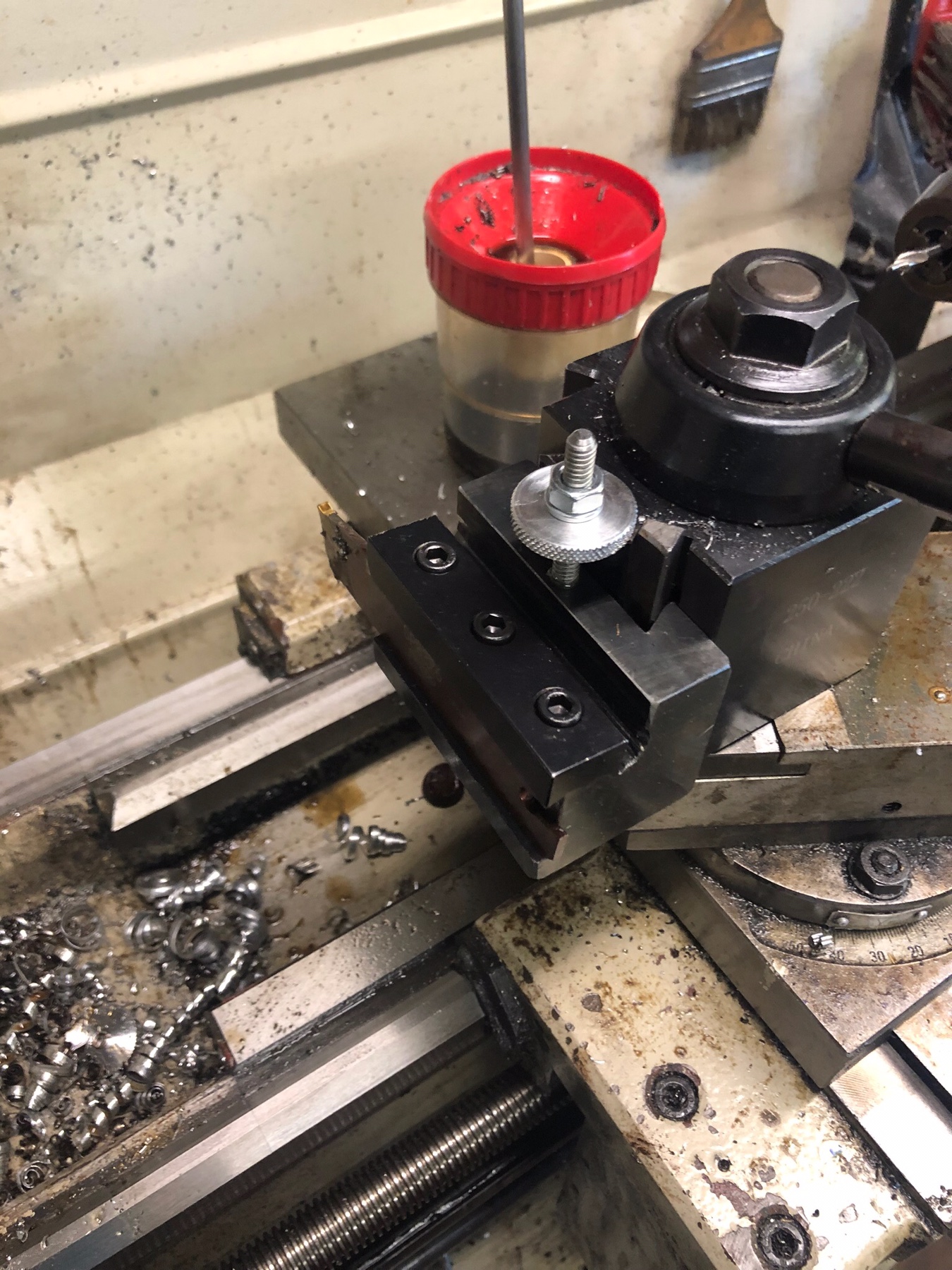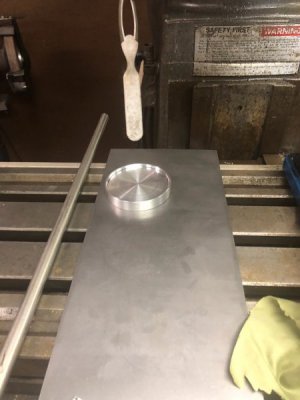-
Welcome back Guest! Did you know you can mentor other members here at H-M? If not, please check out our Relaunch of Hobby Machinist Mentoring Program!
You are using an out of date browser. It may not display this or other websites correctly.
You should upgrade or use an alternative browser.
You should upgrade or use an alternative browser.
tools needed for the home machinist with a lathe and milling machine
- Thread starter ARC-170
- Start date
- Joined
- Feb 17, 2013
- Messages
- 4,406
Just had a somewhat related thought ...
I've not worked as a machinist, so I may be somewhat off base. I'll be more than happy to hear from any of you "real" guys.
Anyway, my understanding is that professional machinists are expected to have their own measurement and setup tools. Unusual tools, spare cutters, drill bits, super-precision measuring tools, etc. are there in the tool room. Well, as home machinists, we don't have the luxury of a tool room. So we have to equip ourselves with whatever seldom-used tools we need or might anticipate needing. Guess that's just the way things go.
I also recall the "sticker shock" when, shortly after retiring from HP, I had to purchase something other than the common stuff you can get at Home Depot. I was so used to just writing up a requisition and letting the purchasing department take it from there. It was all "funny money" ... until I had to pay it myself!
I've not worked as a machinist, so I may be somewhat off base. I'll be more than happy to hear from any of you "real" guys.
Anyway, my understanding is that professional machinists are expected to have their own measurement and setup tools. Unusual tools, spare cutters, drill bits, super-precision measuring tools, etc. are there in the tool room. Well, as home machinists, we don't have the luxury of a tool room. So we have to equip ourselves with whatever seldom-used tools we need or might anticipate needing. Guess that's just the way things go.
I also recall the "sticker shock" when, shortly after retiring from HP, I had to purchase something other than the common stuff you can get at Home Depot. I was so used to just writing up a requisition and letting the purchasing department take it from there. It was all "funny money" ... until I had to pay it myself!
- Joined
- Feb 9, 2017
- Messages
- 5,249
Just had a somewhat related thought ...
I've not worked as a machinist, so I may be somewhat off base. I'll be more than happy to hear from any of you "real" guys.
Anyway, my understanding is that professional machinists are expected to have their own measurement and setup tools. Unusual tools, spare cutters, drill bits, super-precision measuring tools, etc. are there in the tool room. Well, as home machinists, we don't have the luxury of a tool room. So we have to equip ourselves with whatever seldom-used tools we need or might anticipate needing. Guess that's just the way things go.
I also recall the "sticker shock" when, shortly after retiring from HP, I had to purchase something other than the common stuff you can get at Home Depot. I was so used to just writing up a requisition and letting the purchasing department take it from there. It was all "funny money" ... until I had to pay it myself!
THIS! There is a ton of peripherals that go into a shop. 30yrs before I needed a mill and lathe I needed a compressor, horizontal bandsaw and welder. Started out stick then a small Lincoln 175mig and small Hypertherm 35 plasma. So there is a lot involved with metal working and most of that would be part of the shops I worked in and necessary for doing projects in my shop. I've learned I don't need large expensive industrial units and not buying from industrial suppliers I can get good usable equipment for a fraction of what the shops paid for them.
If producing parts or assemblies where the radii are the major feature of the function then radius gauges are essential, if some one simply likes radiused corners for aesthetic reasons they are not required, make the part as visually appealing as you like.I'm ready to make dies for my bead roller and Planishing hammer and radius gages are essential. There would be no way to do it accurately otherwise. I guess it's a good thing they are pooh poohed because I was able to pick up a basically new Starrett set off eBay for less than a new import set!
The only other consideration is if making parts for a customer that will actually measure them and reject the ones that are nonconforming, this will not likely happen outside of the aerospace, automotive and medical implant industries. If you are producing parts for consumer gardening equipment and the drawing specifies a .010" radius and you make it .015" no one will likely ever actually measure it.
- Joined
- Oct 11, 2016
- Messages
- 3,857
I agree in principle with you Mr Waller, but I like the reassurance of using my radii gauges when I'm finishing. I recognize it is unlikely to be anyone else's preferred way, but it is mine... I'm not really going for accuracy, just consistency.
Most small shops <25 employees would not likely require a prospective employee to own large measuring tools or hundreds of smaller tools that have a limited size range such as bore micrometers as seen here http://www.starrett.com/metrology/m...isplayMode=grid&itemsPerPage=24&sortBy=wp/ascJust had a somewhat related thought ...
I've not worked as a machinist, so I may be somewhat off base. I'll be more than happy to hear from any of you "real" guys.
Anyway, my understanding is that professional machinists are expected to have their own measurement and setup tools. Unusual tools, spare cutters, drill bits, super-precision measuring tools, etc. are there in the tool room. Well, as home machinists, we don't have the luxury of a tool room. So we have to equip ourselves with whatever seldom-used tools we need or might anticipate needing. Guess that's just the way things go.
I also recall the "sticker shock" when, shortly after retiring from HP, I had to purchase something other than the common stuff you can get at Home Depot. I was so used to just writing up a requisition and letting the purchasing department take it from there. It was all "funny money" ... until I had to pay it myself!
It would require 10 individual tools to cover the range between .100" and .500", roughly $10,000 worth for a .400" range of measurement.
On the other hand many large companies will not allow out of process tools to be used at all, you can not use your own tool unless it has been documented, numbered, calibrated, added to the tool system, blessed by a high ranking official of the Church, is a non carcinogen and meets all safety and accuracy standards of the ISPWS (International Society of People that Write Standards)
My two cents worth, on comfort items like a mat, shop shoes, that’s a place not to scrimp. The others you need to decide the accuracy of the work your producing. General machine work or precision tool making. Example I just made a batch of aluminum coasters for Christmas presents, they didn’t need to be as precise as the solid cut off tool block I just finished. You can do great work with less expensive tooling, just like most things the better the tooling the easier it is to use. Personally 90% of my indicators are low budget type but they do a good job, on the other hand my go to mics and calipers are high quality but I did find them used.
I do have a Machinery’s Handbook, but the Black book is more practical for my everyday use. In fact I use two wall charts most often. One is an old drill and tap chart that covers % of thread from 70 to 50. Then the decimal equivalent chart. If you need trig the black book has the common triangle formulas and a $1 calculator can do that.
As I said it depends on where you want to go with the precision.
The one piece tool block

 the coasters
the coasters
Sent from my iPad using Tapatalk
I do have a Machinery’s Handbook, but the Black book is more practical for my everyday use. In fact I use two wall charts most often. One is an old drill and tap chart that covers % of thread from 70 to 50. Then the decimal equivalent chart. If you need trig the black book has the common triangle formulas and a $1 calculator can do that.
As I said it depends on where you want to go with the precision.
The one piece tool block

 the coasters
the coasters Sent from my iPad using Tapatalk
- Joined
- Oct 31, 2016
- Messages
- 2,645
I will admit that I didn't read every post in this thread. So if I am repeating something that has already been said I apologize.
You can go nuts buying stuff that you may never need or use. Start with what you have. Let your projects dictate what to buy when you need it. If you have a project where you absolutely need some gizmo because what you have won't do, then buy that gizmo. You will be money ahead in the long run and by buying stuff as you need it you can afford better quality.
You can go nuts buying stuff that you may never need or use. Start with what you have. Let your projects dictate what to buy when you need it. If you have a project where you absolutely need some gizmo because what you have won't do, then buy that gizmo. You will be money ahead in the long run and by buying stuff as you need it you can afford better quality.
- Joined
- Sep 5, 2014
- Messages
- 428
For the price of a couple of cups of Starbucks coffee it's a Why Not.

